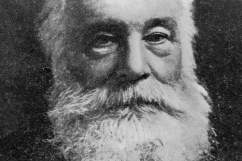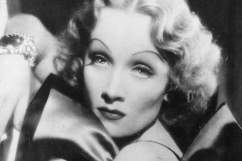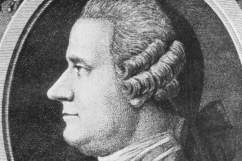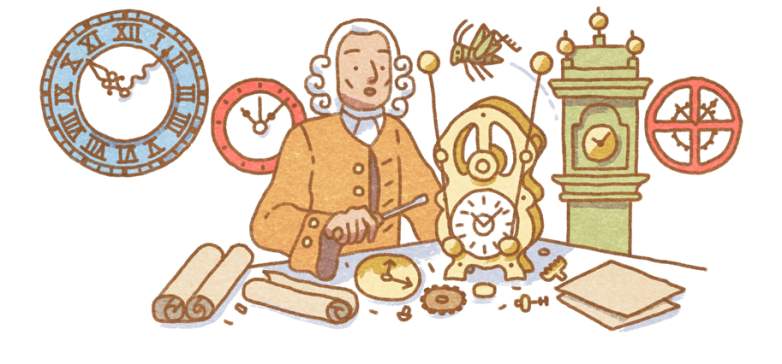
Today’s Google Doodle celebrates the 325th birthday of horologist John Harrison.
English clockmaker, inventor and horologist John Harrison is being celebrated with a Google Doodle on what would have been his 325th birthday.
“It’s been said that necessity is the mother of invention, and without a doubt, British horologist John Harrison brought that age-old proverb to life,” Google says in its Doodle description. “Harrison was a self-educated clockmaker and carpenter who came to the rescue of countless sailors by creating the first marine chronometer to calculate longitude at sea. Our colorful Doodle shows the inventor hard at work, surrounded by the tools of his trade. Today, time is on his side.”
Here’s what you need to know:
1. Harrison Was Born in Yorkshire & Legend Has It That His Love of Clocks Began When He Played & Studied a Watch While Bedridden With Smallpox as a Child
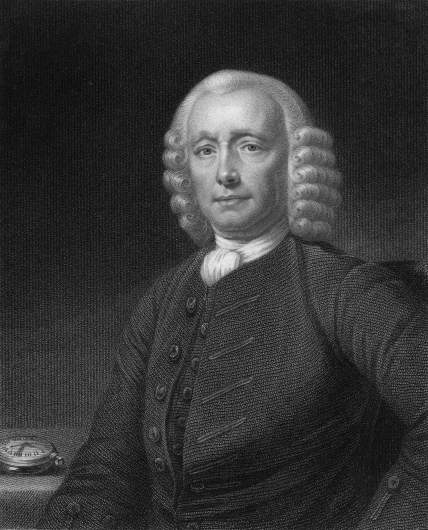
John Harrison in 1768.
John Harrison was born April 3, 1693, in Foulby, near Wakefield in the West Riding of Yorkshire. He was the oldest of five children. His father was a carpenter and Harrison would later learn that trade from him, according to Gettysburg University.
According to legend, Harrison was bedridden with smallpox as a young child. He was given a watch by his parents and that began his fascination with clocks.
“An attack of smallpox at the age of six may have been decisive in shaping his life. While convalescing, he became fascinated by a watch his parents, seeking to amuse him, had laid on his pillow,” historian John Wilford wrote for Survey History. “He never forgot that watch.”
2. He Was a Self-Taught Clockmaker & Built His First Longcase Clock With His Brother When He Was Only 20
Harrison learned the carpentry trade from his father, but was a mostly self-taught clockmaker, according to The Guardian.
He was only 20 when he built his first longcase clock.
“Although a carpenter by trade, Harrison’s father occasionally repaired clocks, and young John assisted his father in his work as soon as he was old enough. As he grew older, Harrison combined his interest in woodworking and timepieces to begin building clocks and completed his first longcase clock, more commonly called a grandfather clock, in 1713 at the age of 20,” according to ASME.org.
He worked often with his younger brother, James, according to Gettysburg University:
During the latter part of his early career, he worked with his younger brother James. Their first major project was a revolutionary turret clock for the stables at Brocklesby Park, seat of the Pelham family. The clock was revolutionary because it required no lubrication. 18th century clock oils were uniformly poor and one of the major causes of failure in clocks of the period. Rather than concentrating on improvements to the oil, Harrison designed a clock which didn’t need it. It was radical thinking of this sort that would be important later on, when he tackled the problem of designing a marine timekeeper.
During the mid-1720s, John and James designed a series of remarkable precision longcase clocks, to see how far they could push the capabilities of the design. By inventing a pendulum rod made of alternate wires of brass and steel, Harrison eliminated the problem of the pendulum’s effective length increasing in warmer weather, slowing the clock. As a result, Harrison’s regulators from this period achieved an accuracy of one second in a month, a performance far exceeding the best London clocks of the day.
3. He Invented a Marine Chronometer That Solved the Problem of Calculating Longitude at Sea, an Instrument That Britain Offered a £20,000 Prize for After 1,550 Sailors Died & 4 Warships Wrecked in 1707
In 1714, the British Parliament passed the Longitude Act, an effort to solve the problem sailors faced in calculating longitude at sea. The act came seven years after 1,550 sailors died when four British warships wrecked in the Scilly naval disaster of 1707. The Longitude Act offered a £20,000 for a solution.
According to Royal Museums Greenwich, “Harrison came to London in about 1727–28, looking for support and the rewards promised by the 1714 Longitude Act.”
He then created several timepieces over many years before eventually creating a solution that revolutionized navigation and made long sea voyages safer.
“Harrison’s extraordinary invention brought him much acclaim. Thanks to him, seamen could determine not only gauge latitude but longitude, making their excursions far safer,” Google says in its Doodle description.
Harrison created a marine timekeeper, now called the H1, with the help of his brother, and in May 1736, it was tested at sea.
“In May 1736, Harrison and H1 were taken aboard HM ship Centurion, about to set sail for Lisbon,” according to Royal Museums Greenwich. “The voyage out started poorly for both Harrison and his clock. But he had his machine going more reliably by the time they reached Lisbon, where it was transferred to the Orford for the return, with much better results. As they neared England, Harrison announced – correctly – that a headland the officers had thought was the Start was in fact the Lizard: they were sixty miles off course and in danger.”
In 1737, Harrison was awarded funding to allow him to improve the clock.
He finished a second marine timepiece, the H2, two years later, but it was never tested. He then spent 19 years working on the H3, “It was running and being tested within five years but it became clear that the clock would struggle to keep time to the accuracy desired, forcing him to make changes and adjustments,” according to RMG.
He would go on to create two more marine timepieces, the H4 and H5, and those proved to be extremely accurate.
“Finally, after 40 years of work, he produced H4, a timepiece that resembled a large pocket watch. This clock not only met the requirements for Parliament’s top prize in a trial but greatly exceeded them,” according to ASME.org. “However, for various reasons including that members wanted to win the prize themselves, the Royal Society, which administered the prize money, awarded only a portion of the money and asked for more tests. When the clock did even better, they doled out another portion of the money. But it took the intervention of King George III to get Harrison his full reward and recognition, some 12 years after the horologist had fulfilled the original conditions. Harrison was then 80 years old.”
Harrison never received the original prize, but was rewarded handsomely for his efforts and was given several grants to continue his research, along with other monetary benefits.
“Harrison was eventually awarded a considerable sum of money for his efforts and he died a rich man,” according to The Guardian.
4. A Clock He Designed Was Deemed the ‘Most Accurate Mechanical Clock With a Pendulum Swinging in Free Air’ by the Guinness Book of World Records
In 2015, a clock designed by Harrison was deemed the, “most accurate mechanical clock with a pendulum swinging in free air,” by the Guinness Book of World Records, according to The Guardian. The timepiece, known as Clock B, was tested over 100 days.
The award from the Guinness Book of World Records was vindication for Harrison, who was said to have “an incoherence and absurdity that was little short of the symptoms of insanity,” when he created the clock, according to The Guardian. He had declared he would design a pendulum clock that “was accurate to within a second over a 100-day period.” He was ridiculed and told that would be impossible.
“It is a quite extraordinary achievement and a complete vindication of Harrison, who suffered ridicule over his claim to be able to achieve such accuracy,” Rory McEvoy, curator of horology at the Royal Museums Greenwich, told The Guardian. “This is a wonderful device.”
He added, “What is particularly exciting about this trial is the fact that it presents history in a physical and not a verbal or theoretical manner. It brings real immediacy to a historical issue: in this case the measurement of time.”
5. Harrison, Who Died in 1776 on His 83rd Birthday, Finished 39th in the BBC’s Poll of the 100 Greatest Briton in History
Harrison died in London on April 3, 1776, on his 83rd birthday. He was married twice and had three children. One of his sons, William Harrison, helped him with his work on the chronometer, and took it on a test voyage to Jamaica. Harrison, who lived in Red Lion Square in London, is buried at St. John’s Church in Hampstead.
He received awards during his life and has been celebrated after his death. In 1749, Harrison was awarded the Copley Medal, the scientific award given by the Royal Society for “outstanding achievements in research in any branch of science.”
In 2002, Harrison finished 39th in a BBC poll of British heroes.
Harrison’s H1, H2, H3 and H4 timepieces were rediscovered after World War I and can now be seen at the Royal Greenwich Observatory. His H5 can be seen at the Science Museum in London.
